Question 1.
The radii of two circles are 19 cm and 9 cm respectively. Find the radius of the circle which has circumference equal to the sum of the circumferences of the two circles.
Solution:
Given: radius of 1st circle (R1) = 19 cm
∴ Circumference of 1st circle = 2πR1 = 2π(19) cm
Radius of 2nd circle (R2) = 9 cm
∴ Circumference of 2nd circle = 2πR2 = 2π(9) cm
Let radius of 3rd circle be R3
Circumference of 3rd circle = 2πR3
According to question,
2πR1 + 2πR2 = 2πR3
⇒ 2π(R1 + R2) = 2πR3
⇒ R1 + R2 = R3
⇒ 19 + 9 = R3
⇒ R3 = 28 cm
Question 2.
The radii of two circles are 8 cm and 6 cm respectively. Find the radius of the circle having area equal to the sum of the areas of the two circles.
Solution:
Given: radius of 1st circle (R1) = 8 cm
Area of 1st circle = πR12 = π(8)2cm2
Radius of 2nd circle (R2) = 6 cm
Area of 2nd circle = πR22 = π(6)2 cm2
Let radius of 3rd circle be R3
Area of 3rd circle = πR32
According to question,
πR,2 + πR22 – πR32
⇒ R12 + R22 = R32 ⇒ (8)2+ i6)2 - R32
⇒ 64 + 36 = R32 ⇒ R3=√100= 10 cm
Question 3.
The figure depicts an archery target marked with its five scoring regions from the centre outwards as Gold, Red, Blue,
Black and White. The diameter of the region representing Gold score is 21 cm and each of the other bands is 10.5 cm wide. Find the area of each of the five scoring regions.
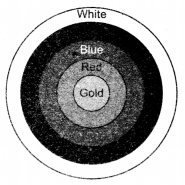
Solution:
Diameter of the region representing gold score is 21 cm
⇒ Radius of the region representing gold region = 21/2 cm
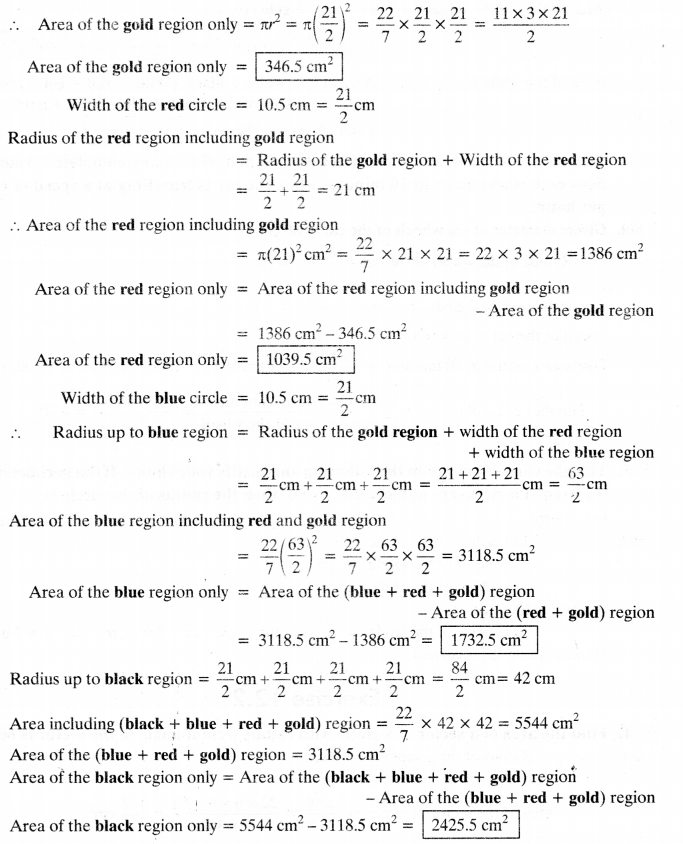


Question 4.
The wheels of a car are of diameter 80 cm each. How many complete revolutions does each wheel make in 10 minutes when the car is travelling at a speed of 66 km per hour?
Solution:
Given:diameter of the wheels of the car = 80 cm
⇒ Radius of the wheel of the car = 80/2 = 40 cm
Circumference of the wheel = 2πr = 2 x 22/2 x 40 cm
Speed of the car = 66 km/h
Distance covered in 10 minutes =66x10/60 = 11 km
= 11 x 1000 x 100 cm = 11,00,000 cm

Question 5.
Tick the correct answer in the following and justify your choice: If the perimeter and the area of a circle are numerically equal, then the radius of the circle is
(a) 2 units
(b) n units
(c) 4 units
(d) 7 units
Solution:
Let radius of the circle = r units
Perimeter of the circle = 2πr
Area of the circle = πr2
According to question,
Perimeter of the circle = Area of the circle
⇒ 2πr = πr2
⇒ r = 2 units
Hence, option (a) is correct.
Areas Related to Circles Ex 12.2
Question 1.
Find the area of a sector of a circle with radius 6 cm if angle of the sector is 60°.
Solution:
Radius of the sector (r) = 6 cm
Central angle of the sector = 60°

Question 2.
Find the area of a quadrant of a circle whose circumference is 22 cm.
Solution:
Let radius of the circle = r
∴ Circumference of the circle = 2πr

Question 3.
The length of the minute hand of a clock is 14 cm. Find the area swept by the minute hand in 5 minutes.
Solution:
Length of minute hand of the clock = 14 cm

Question 4.
A chord of a circle of radius 10 cm subtends a right angle at the centre. Find the area of the corresponding:
(i) minor segment
(ii) major segment (Use ? = 3.14)
Solution:
Given: radius of the circle = 10 cm
Angle subtended by chord at centre = 90°
(i) Area of the minor segment
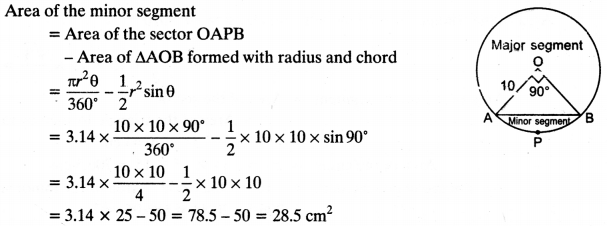
(ii) Area of the major segment = Area of the circle – Area of the minor segment
= πr2 – 28.5 = 3.14 x 10 x 10-28.5
= 314-28.5 = 285.5 cm2
Question 5.
In a circle of radius 21 cm, an arc subtends an angle of 60° at the centre. Find:
(i) length of the arc.
(ii) area of the sector formed by the arc.
(iii) area of the segment formed by the corresponding chord.
Solution:
Radius of the circle = 21 cm
Angle at the centre = 60°

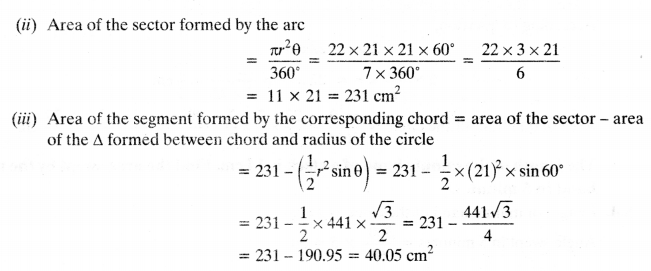
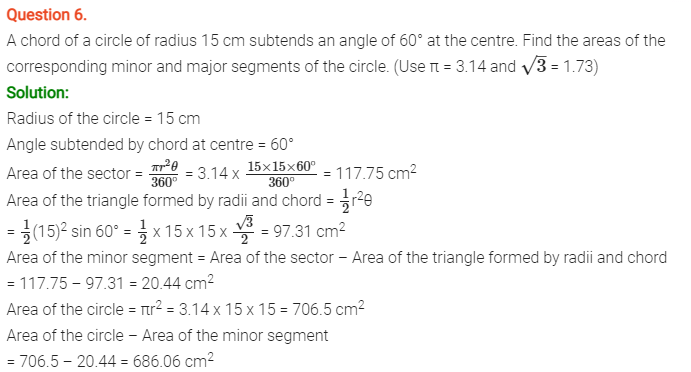
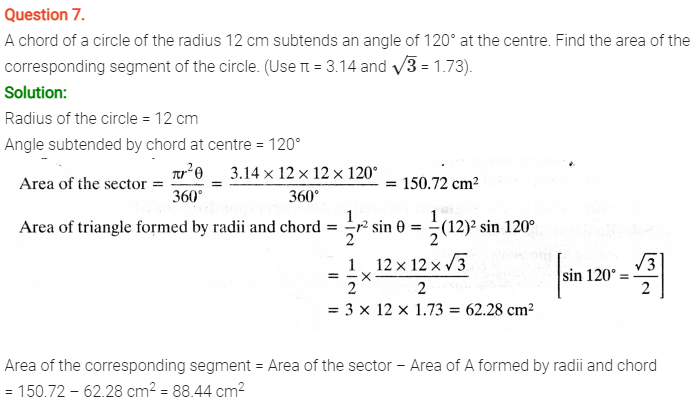
Question 8.
A horse is tied to a peg at one corner of a square shaped grass field of side 15 m by means of a 5 m long rope (see figure). Find
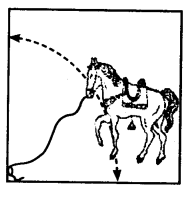
(i) the area of that part of the field in which the horse can graze.
(ii) the increase in the grazing area if the rope were 10 m long instead of 5 m. (Use n = 3.14)
Solution:
(i) Length of the rope = Radius of the sector grazed by horse = 5 m
Here, angle of the sector = 90°

Length of the rope is increased from 5 m to 10 m
New radius of sector grazed by horse = 10 m

Question 9.
A brooch is made with silver wire in the form of a circle with diameter 35 mm. The wire is also used in making 5 diameters which divide the circle into 10 equal sectors as shown in figure.
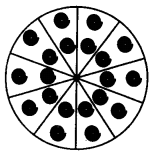
Find:
(i) the total length of the silver wire required.
(ii) the area of each sector of the brooch.
Solution:
Length of one diameter = 35 mm
Total length of 5 diameters = 5 x 35 mm = 175 mm
Circumference of the circle = 2π = 2 x 22/7 x35/2= 110 mm
(i) Total length of the wire used = length of 5 diameters + circumference of brooch
= 175 + 110 = 285 mm
(ii) Total sectors are 10.

Question 10.
An umbrella has 8 ribs which are equally spaced (see figure). Assuming umbrella to be a flat circle of radius 45 cm, find the area between the two consecutive ribs of the umbrella.
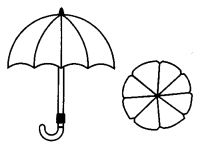
Solution:
Radius of the circle = 45 cm
Number of ribs = 8

Question 11.
A car has two wipers which do not overlap.
Each wiper has a blade of length 25 cm sweeping through an angle of 115°. Find the total area cleaned at each sweep of the blades.
Solution:
Given: length of blade of wiper = radius of sector sweep by blade = 25 cm
Area cleaned by each sweep of the blade = area of sector sweep by blade
Angle of the sector formed by blade of wiper =115°
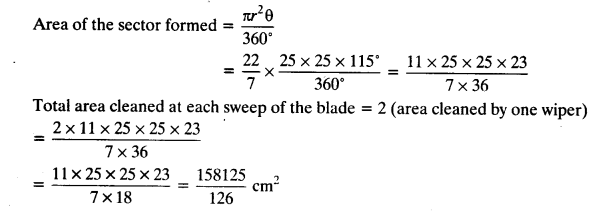
Question 12.
To warn ships for underwater rocks, a lighthouse spreads a red coloured light over a sector of angle 80° to a distance of 16.5 km. Find the area of the sea over which the ships are warned. (Use π = 3.14)
Solution:
Angle of the sector = 80°
Distance covered = 16.5 km
Radius of the sector formed = 16.5 km

Question 13.
A round table cover has six equal designs as shown in the figure. If the radius of the cover is 28 cm, find the cost of making the designs at the rate of ₹ 0.35 per cm2. (Use √3 = 1.7)
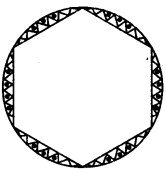
Solution:
Radius of the cover = 28 cm
∵ There are six equal designs
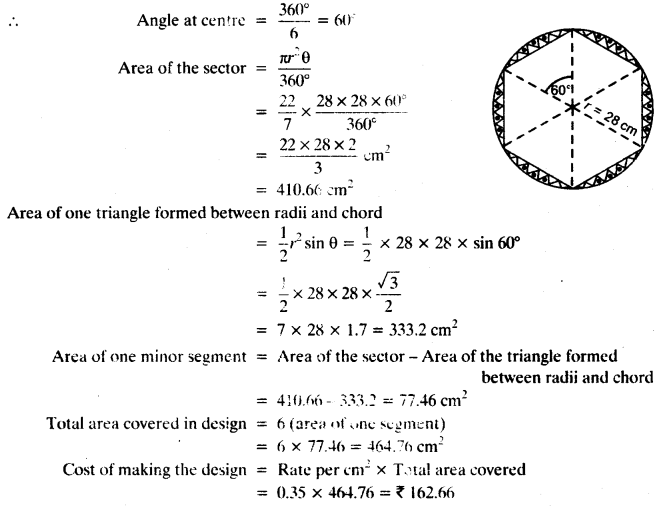
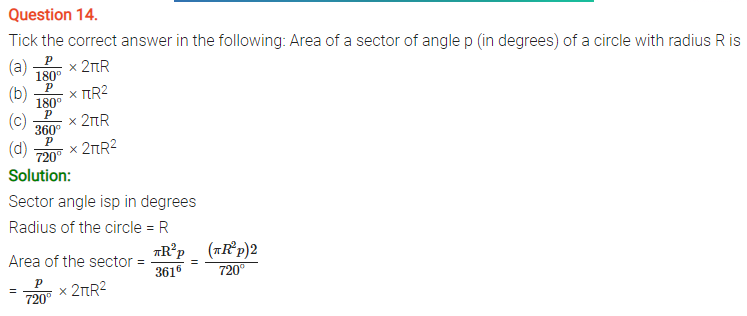
Areas Related to Circles Ex 12.3
Question 1.
Find the area of the shaded region in the given figure, if PQ = 24cm, PR = 7cm and O is the centre of the circle.
Solution:
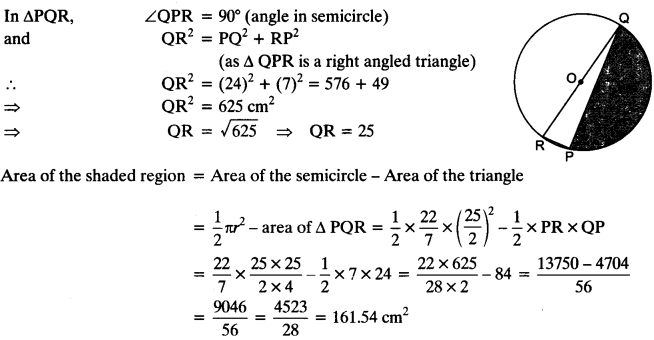
Question 2.
Find the area of the shaded region in the given figure, if radii of the two concentric circles with centre O are 7 cm and 14 cm respectively and ∠AOC = 400.
Solution:
∠AOC = 40° (given)
Radius of the sector AOC = 14 cm
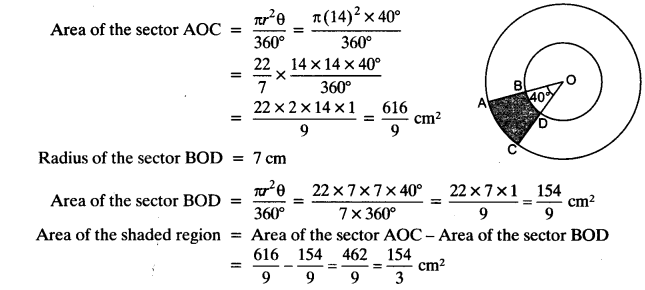
Question 3.
Find the area of the shaded region in the given figure, if ABCD is a square of side 14 cm and APD and BPC are semicircles.
Solution:
ABCD is a square
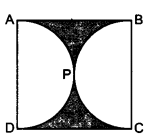
Given: side of the square = 14 cm
∴ Area of the square = (side)² = (14)² = 196 cm²
Radius of the semicircle APD =1/2(side of square) =1/2 x 14 = 7 cm
Area of the semicircle APD =1/2 πr² = 1/2 × 22/7 × 7 × 7 = 11 × 7 = 77cm²
Similarly, area of the semicircle BPC = 77 cm²
Total area of both the semicircles = 77 + 77 = 154 cm²
Area of the shaded region = Area of square - area of both semicircles
= 196 - 154 = 42 cm²
Question 4.
Find the area of the shaded region in the figure, where a circular arc of radius 6 cm has been drawn with vertex O of an equilateral triangle OAB of side 12 cm as centre.
Solution:
Area of the equilateral triangle OAB

Question 5.
From each corner of a square of side 4 cm a quadrant of a circle of radius 1 cm is cut and also a circle of diameter 2 cm is cut as shown in the figure. Find the area of the remaining portion of the square.
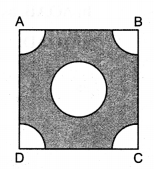
Solution:
Given: side of the square ABCD = 4 cm
Area of the square ABCD = 4 x 4 = 16 cm²
Radius of the quadrant at corner = 1 cm
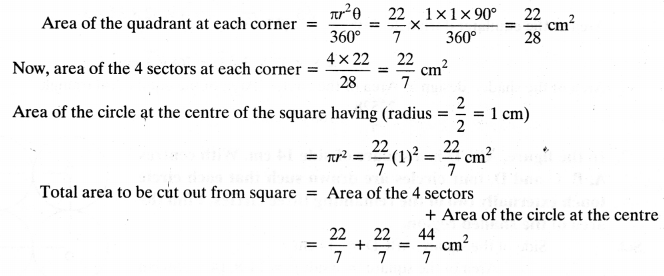
∴ Area of the remaining portion = Area of the square – Area to be cut from square
= 16 - (44/7) = 16 - 44/7
=112-44/7 =68/7cm²
Question 6.
In a circular table cover of the radius 32 cm, a design is formed leaving an equilateral triangle ABC in the middle as shown in the figure. Find the area of the design (shaded region)
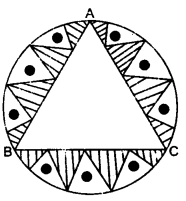
Solution:
Radius of the circle(r) = 32cm
Area of the circle = πr²
= 22/7 × 32 × 32 = 22528/7cm²
∴ An equilateral triangle is formed in the circle as shown
Angle subtended by et ch side at centre
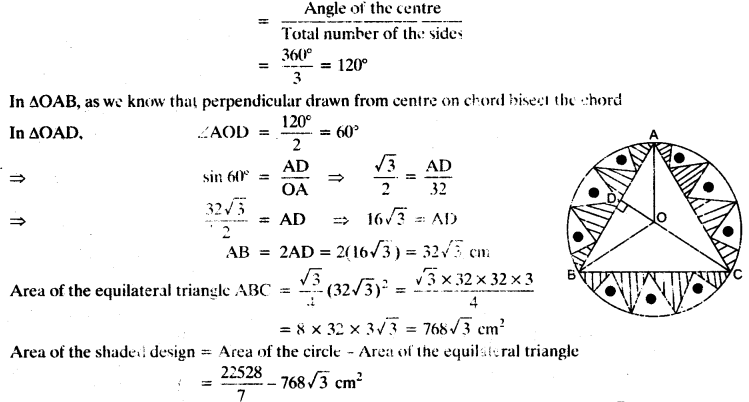
Question 7.
In the figure, ABCD is a square of side 14 cm. With centres A, B, C and D, four circles are drawn such that each circle touch externally two of the remaining three circles. Find the area of the shaded region.
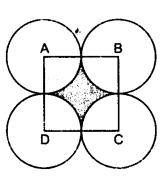
Solution:
Side of the square ABCD = 14 cm
Area of the squat e = (side)² = 14 x 14 = 196²
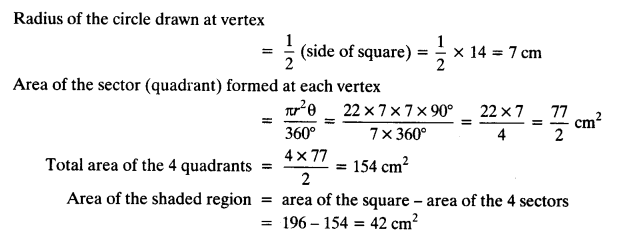
Question 8.
The given figure depicts a racing track whose left and right ends are semicircular. The distance between the two inner parallel line segments is 60 m and they are each 106 m long. If the track is 10 m wide, find:

(i) the distance around the track along its inner edge.
(ii) the area of the track.
Solution:
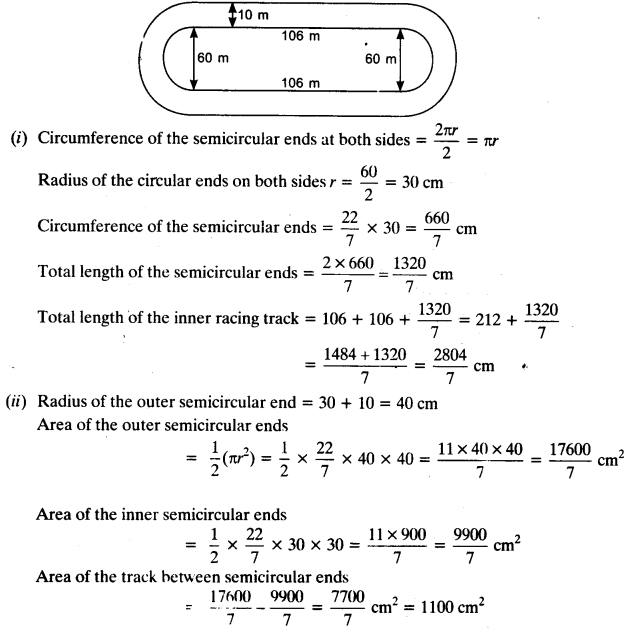
Area of the tracks at both semicircular ends = 2 x 1100 = 2200 cm²
Area of the 2 rectangular portions = 2 x l x h = 2 x 106 x 10 = 2120 cm²
Total area of the track = area of the track at semicircular ends + area of the rectangular portions
= 2200 + 2120 = 4320 cm²
Question 9.
In the figure, AB and CD are two diameters of a circle (with centre O) perpendicular to each other and OD is the diameter of the smaller circle. If OA = 7 cm, find the area of the shaded region.
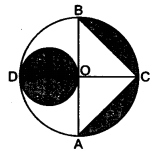
Solution:
Given: OA = 7 cm
Radius of the semicircle ABC = OA = 7 cm
Area of the semicircle ABC = 1/2πr² = 1/2 x 22/7 x 7 x 7 = 11 x 7 = 77 cm²
Diameter AB = 2(OA) = 2 x 7 = 14 and OA = OC = 7 cm (radius)
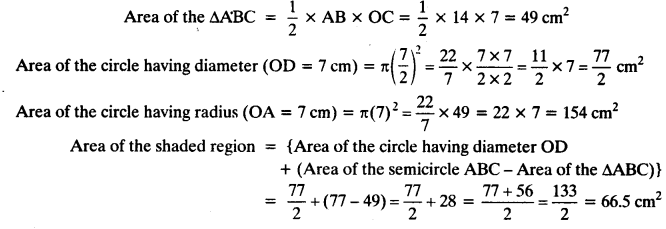
Question 10.
The area of an equilateral triangle ABC is 17320.5 cm². With each vertex of the triangle as centre, a circle is drawn with radius equal to half the length of the side of the triangle (see figure). Find the area of the shaded region.
(Use π = 3.14 and √3 = 1.73205).
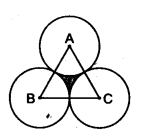
Solution:
Given: area of an equilateral triangle ABC = 17320.5 cm²
Let side of the triangle AB’C be ‘a’
∴ Area of the ∆ABC = = √3/4a²
√3/4a²=17320.5
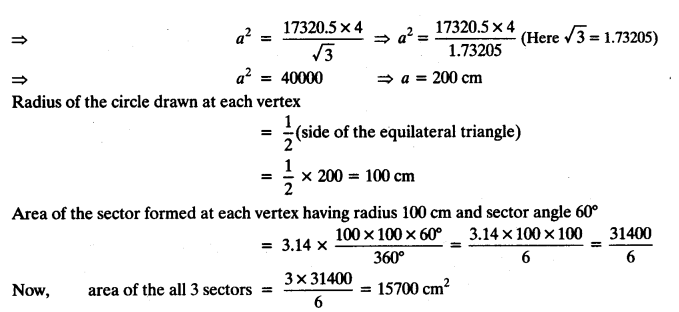
Now,
area of the all 3 sectors = 3×31400/6 = 15700 cm²
∴ Area of the shaded portion = Area of the equilateral triangle
- Area of the three sectors formed at each vertex)
= 17320.5 – 15700 = 1620.5 cm²
Question 11.
On a square handkerchief, nine circular designs each of the radius 7 cm are made (see figure). Find the area of the remaining portion of the handkerchief.
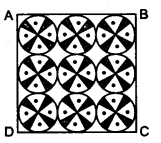
Solution:
Radius of the one circular design = 7 cm
Area of the one circular design = πr² = 22/7 x 7 x 7 = 154 cm²
Now, area of the 9 circular designs = 9 x 154 = 1386 cm²
Diameter of the circular design = 7 x 2 = 14 cm
Side of the square = 3(diameter of one circle) = 3 x 14 = 42 cm
Area of the square = 42 x 42 = 1764 cm²
Area of the remaining portion of handkerchief
= Area of the square – (Area of the 9 circular designs)
= 1764 – 1386
= 378 cm²
Question 12.
In the figure, OACB is a quadrant of a circle with centre O and radius 3.5 cm. If OD = 2 cm, find the area of the (i) quadrant OACB, (ii) shaded region.
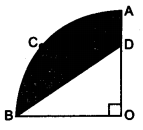
Solution:
(i) Radius of the quadrant OACB = 3.5 cm

(ii) OD = 2cm and OB = 3.5 cm

Question 13.
In the figure, a square OABC is inscribed in a quadrant OPBQ. If OA = 20 cm, find the area of the shaded region. (Use re = 3.14)
Solution:
Given: side of the square OABC = OA = 20 cm
Area of the square = 20 x 20 = 400 cm²
(Diagonal of the square)² = (side of the square)² + (side of the square)² (By pythagoras theorem)
Diagonal of the square = √2 x (side of the square)
= √2 x (20) = 20 √2cm
Radius of the quadrant of circle = Diagonal of square = 20 √2

Question 14.
AB and CD are respectively arcs of two concentric circles of radii 21 cm and 7 cm and centre O (see figure). If ∠AOB=30°, find the area of the shaded region.
Solution:
Given: ∠AOB = 30°
Radius of the sector AOB = 21 cm
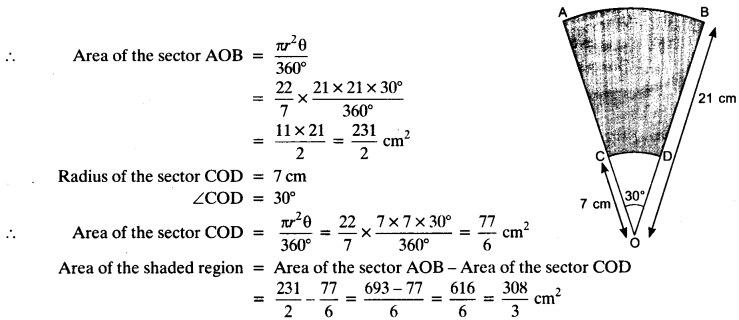
Question 15.
In the figure, ABC is a quadrant of a circle of radius 14 cm and a semicircle is drawn with BC as diameter. Find the area of the shaded region.
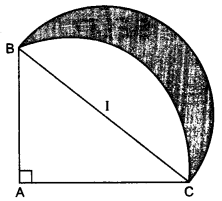
Solution:
Radius of the quadrant of the circle = 14 cm
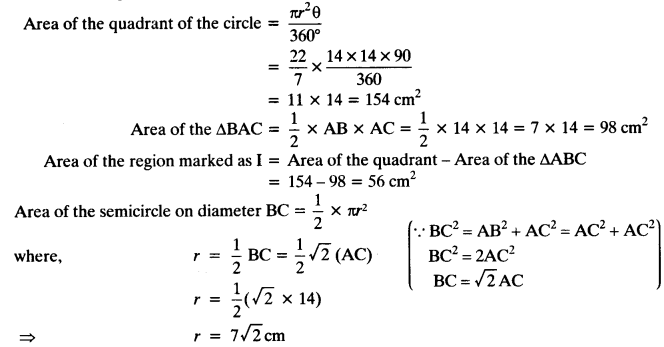
Area of the shaded region = Area of the semicircular region – Area of the region I
= 154 cm² – 56 cm² = 98 cm²
Question 16.
Calculate the area of the designed region in the figure common between the two quadrants of the circles of the radius 8 cm each.
Solution:
Side of the square = 8 cm
Area of the square = 8 x 8 = 64 cm²
Radius of the quadrant (formed at vertex) = 8 cm
